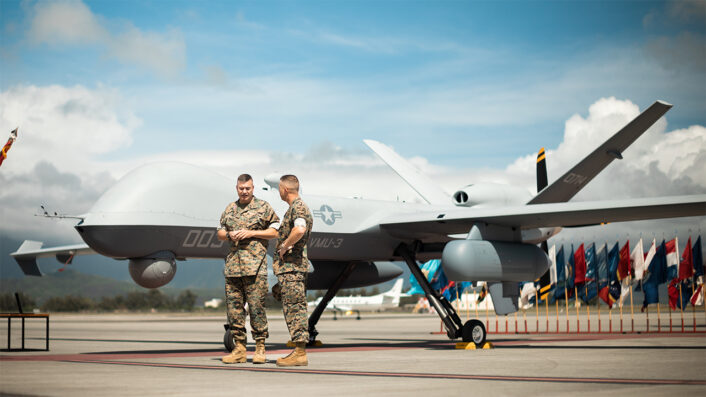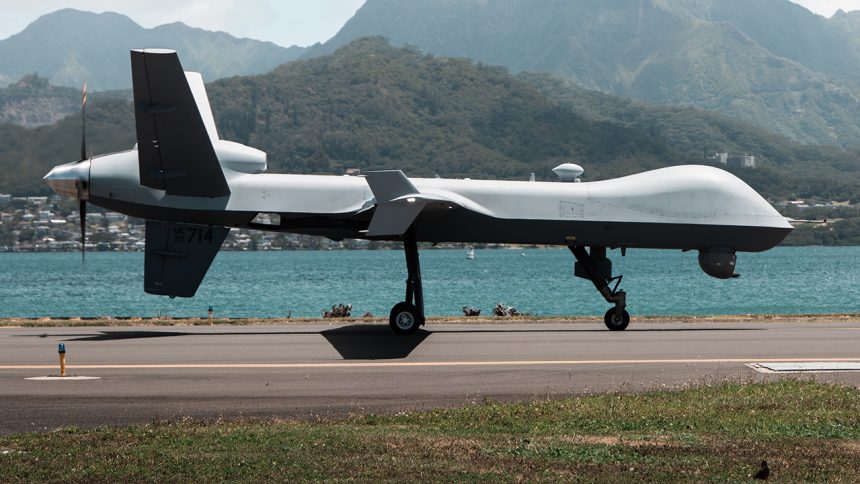Chinese Coast Guard vessels have been ramming into Philippine vessels, damaging them, and firing high-power water cannons into resupply ships.
Amid continuing tensions between the Philippines and China in the SCS (South China Sea), as the latter blocks Manila’s resupply missions to the BRP Sierra Madre over the disputed Second Thomas Shoal, USMC (U.S. Marine Corps) MQ-9A Reaper drones are now operating out of Basa Air Base, reports said.
CCG (China Coast Guard) vessels and ‘cutters’ frequently intercept Philippine coast guard ships and supply vessels replenishing the abandoned World War II-era Sierra Madre, which Manila left there as an “outpost” to mark its territorial claim.
The Reapers would operate on a “rotational” basis and will be “temporarily stationed” in the country, in line with the 2014 EDCA (Enhanced Defense Cooperation Agreement), providing continuous aerial surveillance capability to the Philippine military. “Temporarily” is a key word here as the country’s 1987 constitution prohibits the permanent basing of foreign military forces in its territory.
The MQ-9s are assigned with the I MEF (I Marine Expeditionary Force) and their mission there was confirmed by the unit’s spokesperson to USNI News. Under EDCA, Basa is also slated to receive a slew of US-funded upgrades. So far, it has undergone runway renovation and expansion, received a new command and control facility and also hosts a humanitarian assistance and disaster relief warehouse.
The Dawn of US Drones in the SCS?
This is not the first time American drones are operating from the Philippines to oversee Chinese military assertions of its territorial claims, as during summer 2023 U.S. Army’s MQ-1C Grey Eagle drones operated from Edwin Andrews Air Base in the southern part of the country. The Reaper’s deployment also comes after the MQ-9A was inducted into the VMU-3 (Marine Unmanned Aerial Vehicle Squadron 3) at Kaneohe Bay in Hawaii on Aug. 2, 2023.

On May 8, 2024, MQ-9As were also involved in a sinking exercise during the Balikatan 2024 drills between the U.S. and Philippines. During the SINKEX the Philippine Navy flagship BRP Jose Rizal fired a SSM-700K C-Star anti-ship missile at the decommissioned tanker BRP Lake Caliraya, which was also struck by Philippine Air Force FA-50 and U.S. Air Force F-16C fighters.
The MQ-9A Reaper is a MALE (Medium Altitude Long-Endurance)-class UAV, capable of performing multi-mission ISR (Intelligence, Surveillance and Reconnaissance) missions over land or sea. With an external payload capacity of 1,361 kg on six wing hardpoints, it can fly for 27 hours and reach altitudes of 50,000 feet. The aircraft carries a MTS-B EO/IR (Electro-Optical/Infrared) turret, a Lynx Multi-mode Radar, a Multi-mode Maritime Radar, an Automated Identification System and communications relay systems.
#China Coast Guard blasting water cannons at #Philippines supply vessel Unaizah May 4 during a resupply mission to Ayungin (Second Thomas) Shoal in the West Philippine Sea on March 23.
Unaizah May 4 was severely damaged by the water cannons.pic.twitter.com/a7MTnGMJrP
— Indo-Pacific News – Geo-Politics & Defense (@IndoPac_Info) March 23, 2024
According to the reports, after the rotational deployment of the Reapers at Basa AB ends, it is likely that the MQ-1C Grey Eagles resume their flights from Edwin Andrews AB. The duration of the temporary assignment at Basa or the number of MQ-9s based there has not been disclosed.
There is a veil of secrecy surrounding the presence of the Reapers there, after the PACAF (Pacific Air Forces) retracted a press release issued in March, as reported by USNI News. That now withdrawn statement mentioned the Pacific Air Forces Agile Combat Employment mission secured “vital logistical support for permanent USMC MQ-9A” at Basa Air Base.
The release also described the missions undertaken during this deployment, including five sorties over the South China Sea to support “critical maritime domain awareness and overwatch of the Second Thomas Shoal,” which was described as “a landmark symbol of the Philippines’ stand against China’s territorial ambitions in the region.”
More Diplomatic Intent than Military
The UAVs, meanwhile, do not conceivably appear to be geared to undertake combat missions. It rather looks like a symbolic move, reassuring Manila of the U.S.’s backing before its struggle with China. For some time now, CCG vessels have been ramming into Philippine vessels and firing high-power water cannons into resupply vessels attempting to reach the Sierra Madre outpost to resupply the personnel stationed there, damaging the ships and injuring their crews.
Tatlong opisyal ng Philippine Navy ang nagtamo ng injury sa kanilang mata at ulo matapos atakihin ng China Coast Guard vessels ang Philippine supply vessel malapit sa Ayungin Shoal nitong Sabado, March 23. #News5 | via @_GioRobles pic.twitter.com/L8DBw4XO0Q
— News5 (@News5PH) March 25, 2024
This situation raised doubts about the reliability of the U.S. support to Manila, especially as Washington is a signatory to the 1951 U.S.-Philippines Mutual Defense Treaty. The U.S. State Department issued a statement on Mar. 23, 2024, following the water cannon attack on the Unaizah May 4 resupply boat, denouncing China’s dangerous action, although it was viewed as a hurried attempt to assuage the Philippines’ concerns.
“The United States reaffirms that Article IV of the 1951 US-Philippines Mutual Defense Treaty extends to armed attacks on Philippine armed forces, public vessels, or aircraft – including those of its Coast Guard – anywhere in the South China Sea,” US State Department Spokesperson Matthew Miller had said. The seven-decade old defense pact dictates that the US and the Philippines would support each other if either of them were to be attacked by an external party.
However, Manila possibly expects concrete and direct U.S. support like naval vessels sailing together with its ships to physically obstruct and deter the Chinese, beyond the surveillance overflights with reconnaissance aircraft and drones. Beijing meanwhile, at least for the time being, is assured that the U.S. won’t directly intervene either in Taiwan or in the SCS, given its preoccupation in Europe and the Middle East with Iran.









